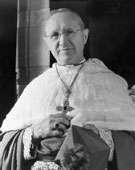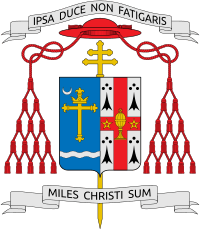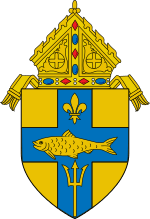Joseph Ritter
Joseph Elmer Ritter (July 20, 1892 – June 10, 1967) was an American prelate of the Roman Catholic Church. He served as Archbishop of St. Louis from 1946 until his death in 1967, and was created a cardinal in 1961. He previously served as auxiliary bishop (1933–34) and bishop (later archbishop) (1934–46) of Indianapolis. Ritter was one of the cardinals elector who participated at the Papal Conclave,1963.
Joseph Elmer Ritter | |
|---|---|
| Cardinal, Archbishop of St. Louis | |
 | |
| See | St. Louis |
| Appointed | July 20, 1946 |
| Term ended | June 10, 1967 |
| Predecessor | John J. Glennon |
| Successor | John Carberry |
| Other posts | Cardinal-Priest of Santissimo Redentore e Sant'Alfonso in Via Merulan |
| Orders | |
| Ordination | May 30, 1917 by Joseph Chartrand |
| Consecration | March 28, 1933 by Joseph Chartrand |
| Created cardinal | January 16, 1961 by John XXIII |
| Rank | Cardinal-Priest |
| Personal details | |
| Born | July 20, 1892 New Albany, Indiana |
| Died | June 10, 1967 (aged 74) St. Louis, Missouri |
| Previous post |
|
| Motto | IPSA DUCE NON FATIGARIS (The leader has not wearied) MILES CHRISTI SUM (I am a soldier of Christ) |

Ordination history of Joseph Ritter | |||||||||||||||||||||
|---|---|---|---|---|---|---|---|---|---|---|---|---|---|---|---|---|---|---|---|---|---|
| |||||||||||||||||||||
| |||||||||||||||||||||
Early life and education
Joseph Ritter was born in New Albany, Indiana, one of six children of Nicholas and Bertha (née Luette) Ritter.[1] His father worked as a baker, and his mother was of German lineage.[2] He received his early education at the parochial school of St. Mary's Church in New Albany.[3] During the seventh grade, Ritter decided to enter the priesthood, later saying, "There was no vision, no voice from heaven. I simply wanted to be a priest."[4] In 1907, he enrolled at St. Meinrad's Seminary in southern Indiana, where he completed his studies in 1917.[1]
Priesthood
Ritter was born July 20, 1892, Ritter was ordained a priest by Bishop Joseph Chartrand at St. Meinrad Archabbey.[5] His first assignment was as a curate at St. Patrick's Church in Indianapolis.[3] Shortly afterwards, he was transferred to Saints Peter and Paul Cathedral, also in Indianapolis.[4] He later served as rector of the cathedral from 1920 to 1933.[1] In 1922, he received an honorary doctorate of theology from Pope Pius XI.[1]
Episcopacy
Indianapolis
On February 3, 1933, Ritter was appointed auxiliary bishop of the Diocese of Indianapolis and titular bishop of Hippos by Pius XI.[5] He received his episcopal consecration on the following March 28 from Bishop Chartrand, with Bishops Alphonse John Smith and Emmanuel Boleslaus Ledvina serving as co-consecrators.[5] At age 40, he was one of the youngest Catholic bishops in the United States.[4] As an auxiliary bishop, he also served as vicar general of the diocese from 1933 to 1934.[2]
Following the death of Bishop Chartrand, Ritter was appointed the seventh Bishop of Indianapolis on March 24, 1934.[5] In 1938, he ordered an end to racial segregation in all Catholic schools in the diocese.[6] His decision, made 16 years before Brown v. Board of Education, was met with opposition by the Ku Klux Klan, whose members protested outside of SS. Peter and Paul Cathedral, and even by his fellow members of the clergy.[7] Also during his tenure, Ritter reorganized the diocesan Catholic Charities, introduced the Catholic Youth Organization, and completed the construction of SS. Peter and Paul Cathedral.[8] He reduced the diocese's debt by $3 million.[3]
The Diocese of Indianapolis was elevated to the status of an archdiocese by Pope Pius XII on October 21, 1944, and Ritter was installed as its first Archbishop on December 19, 1944.[9]
St. Louis
Ritter was appointed the fourth Archbishop of St. Louis, Missouri, by Pius XII on July 20, 1946, succeeding the late Cardinal John J. Glennon.[5] In 1947, as one of his first acts as archbishop, Ritter announced an end to racial segregation in all Catholic schools before the fall term.[8] He declared, "The cross on top of our schools must mean something," and expressed his belief in "the equality of every soul before Almighty God."[10] In response, a group of over 700 white Catholics threatened to sue Ritter on the basis that his directive was contrary to state law.[11] Ritter then issued a pastoral letter in which he warned that any Catholic who brought him to court would incur excommunication; the group subsequently decided to take no action against him.[11] He also desegregated all Catholic hospitals in the archdiocese.[4]
Ritter also forbade Catholics to see The French Line under danger of serious sin,[12] and declared that Catholics must have written permission from the archdiocese to attend secular or non-Catholic colleges.[13] He was one of the first bishops to create a diocesan mission, specifically in La Paz, Bolivia. Until that time, most missions had been conducted by Roman Catholic religious institutes or societies of apostolic life. The people of Saint Louis regularly contributed more money to these foreign missions than any archdiocese of its size. He served as president of the National Catholic Educational Association from 1955 to 1956, and was named an Assistant at the Pontifical Throne on October 5, 1956.[1]
Ritter was created Cardinal Priest of SS. Redentore e S. Alfonso in Via Merulana by Pope John XXIII in the consistory of January 16, 1961.[5] Between 1962 and 1965, he participated in all four sessions of the Second Vatican Council in Rome.[2] Ritter was viewed as a liberal.[14][15] He also protested against the Roman Curia's oppressive actions[15] and Cardinal Alfredo Ottaviani's draft on the sources of Revelation at the Council.[16] On his return to Saint Louis, many Catholics expected him to make several changes to the existing administrative structure to give priests and laity a greater role in Church governance, as recommended by the Council. However, before he could implement such reforms, Ritter died from a heart attack[17] at age 74, one month and ten days short of his next birthday.
Legacy

- Ritter is commemorated by a mosaic tile depiction in the Cathedral Basilica of Saint Louis showing him reaching out toward a group of people from other faiths on one side, and also an integrated group of school children on the other.
- Ritter was a friend of Lionel Hampton[18] and Cardinal Ottaviani.[16]
- In a gesture of ecumenism, Ritter granted his approval to the mixed marriage of a Catholic and an Episcopalian in 1964.[19] He also authorized the first English Mass in the United States.[17]
- Ritter, intensely dedicated to racial equality, even withheld Communion from Catholics who practiced discrimination.[20]
- He was "dismayed" and "indignant" after the rector of Catholic University of America, Monsignor William McDonald, refused to allow certain liberal theologians to speak at the university.[21]
- His birthplace and childhood home in New Albany, Indiana will be turned into a museum about the Cardinal's life (he remains the only Indiana-born Cardinal in the Catholic Church's history, and up until October 2016, when Pope Francis named Indianapolis's incumbent Archbishop, Joseph William Tobin, to the cardinalate [effective in November 2016], Indianapolis- or any other Indiana diocese- was not a cardinalatial see) in three stages. The Cardinal Ritter Birthplace Foundation is promoting this project. The museum will occupy the Ritter family's bakery—its storefront was part of the 1874 Queen Anne-style home.[22]
- A one-hour documentary of Ritter's life was filmed.[23]
- Cardinal Ritter High School in Indianapolis is named in his honor.
- Cardinal Ritter College Prep High School in St. Louis is named in his honor.
See also
- Cardinal electors in Papal conclave, 1963
References
- Curtis, Georgina Pell (1961). The American Catholic Who's Who. XIV. Grosse Pointe, Michigan: Walter Romig.
- Miranda, Salvador. "RITTER, Joseph Elmer (1892-1967)". The Cardinals of the Holy Roman Church.
- "Cardinal Joseph Elmer Ritter". Cardinal Ritter Birthplace Foundation.
- "Joseph Cardinal Ritter, 74, Dies; Liberal Archbishop of St. Louis". The New York Times. 1967-06-11.
- "Joseph Elmer Cardinal Ritter". Catholic-Hierarchy.org. David M. Cheney. Retrieved 21 January 2015.
- "Cardinal Joseph E. Ritter". Marian University. Archived from the original on 2010-05-27. Retrieved 2010-05-17.
- "Cardinal Joseph Ritter: A trailblazer for desegregation in Indianapolis Catholic schools". WISH-TV 8. 2010-02-12. Archived from the original on 2011-09-27.
- Christensen, Lawrence O. (1999). Dictionary of Missouri Biography. Columbia: University of Missouri Press.
- "General history". Roman Catholic Archdiocese of Indianapolis.
- "Religion: Four New Hats". TIME Magazine. 1960-12-26.
- "RACES: Caution!". TIME Magazine. 1947-09-29.
- TIME Magazine. The Censors January 11, 1954
- TIME Magazine. The Letter June 20, 1960
- TIME Magazine. Cum Magno Dolore October 23, 1964
- TIME Magazine. The Unlikely Cardinal August 21, 1964
- TIME Magazine. The Cardinal's Setback November 23, 1962
- TIME Magazine. Milestones June 16, 1967
- TIME Magazine. January 27, 1961
- TIME Magazine. Toward Easier Mixed Marriage July 17, 1964
- TIME Magazine. Waking Up to Race October 4, 1963
- TIME Magazine. Crisis at Catholic U. March 29, 1963
- Plaque marks Cardinal Ritter's birthplace in New Albany Archived 2007-09-28 at the Wayback Machine Newsandtribune.com
External links
| Catholic Church titles | ||
|---|---|---|
| Preceded by Joseph Chartrand |
Archbishop of Indianapolis 1934–1946 |
Succeeded by Paul Clarence Schulte |
| Preceded by John J. Glennon |
Archbishop of Saint Louis 1946–1967 |
Succeeded by John Carberry |

